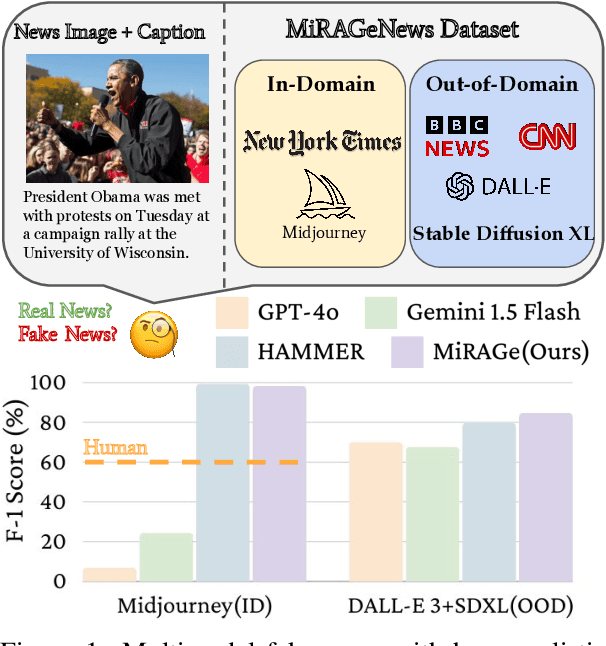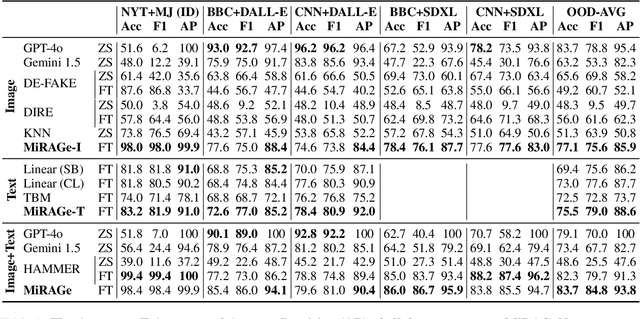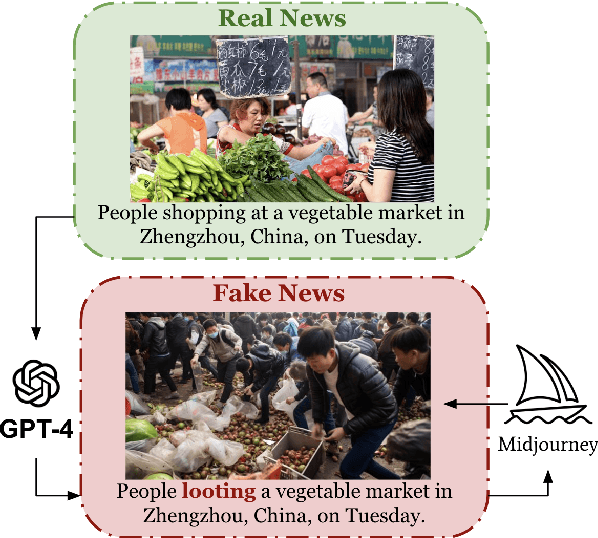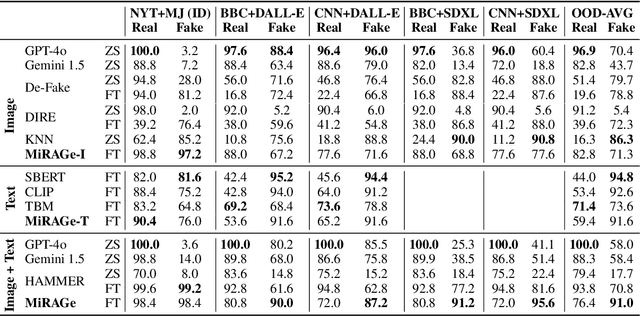Yue Yang
Institute for Transport Studies, University of Leeds, Leeds LS2 9JT, UK
ReBot: Scaling Robot Learning with Real-to-Sim-to-Real Robotic Video Synthesis
Mar 15, 2025Abstract:Vision-language-action (VLA) models present a promising paradigm by training policies directly on real robot datasets like Open X-Embodiment. However, the high cost of real-world data collection hinders further data scaling, thereby restricting the generalizability of VLAs. In this paper, we introduce ReBot, a novel real-to-sim-to-real approach for scaling real robot datasets and adapting VLA models to target domains, which is the last-mile deployment challenge in robot manipulation. Specifically, ReBot replays real-world robot trajectories in simulation to diversify manipulated objects (real-to-sim), and integrates the simulated movements with inpainted real-world background to synthesize physically realistic and temporally consistent robot videos (sim-to-real). Our approach has several advantages: 1) it enjoys the benefit of real data to minimize the sim-to-real gap; 2) it leverages the scalability of simulation; and 3) it can generalize a pretrained VLA to a target domain with fully automated data pipelines. Extensive experiments in both simulation and real-world environments show that ReBot significantly enhances the performance and robustness of VLAs. For example, in SimplerEnv with the WidowX robot, ReBot improved the in-domain performance of Octo by 7.2% and OpenVLA by 21.8%, and out-of-domain generalization by 19.9% and 9.4%, respectively. For real-world evaluation with a Franka robot, ReBot increased the success rates of Octo by 17% and OpenVLA by 20%. More information can be found at: https://yuffish.github.io/rebot/
Every FLOP Counts: Scaling a 300B Mixture-of-Experts LING LLM without Premium GPUs
Mar 07, 2025



Abstract:In this technical report, we tackle the challenges of training large-scale Mixture of Experts (MoE) models, focusing on overcoming cost inefficiency and resource limitations prevalent in such systems. To address these issues, we present two differently sized MoE large language models (LLMs), namely Ling-Lite and Ling-Plus (referred to as "Bailing" in Chinese, spelled B\v{a}il\'ing in Pinyin). Ling-Lite contains 16.8 billion parameters with 2.75 billion activated parameters, while Ling-Plus boasts 290 billion parameters with 28.8 billion activated parameters. Both models exhibit comparable performance to leading industry benchmarks. This report offers actionable insights to improve the efficiency and accessibility of AI development in resource-constrained settings, promoting more scalable and sustainable technologies. Specifically, to reduce training costs for large-scale MoE models, we propose innovative methods for (1) optimization of model architecture and training processes, (2) refinement of training anomaly handling, and (3) enhancement of model evaluation efficiency. Additionally, leveraging high-quality data generated from knowledge graphs, our models demonstrate superior capabilities in tool use compared to other models. Ultimately, our experimental findings demonstrate that a 300B MoE LLM can be effectively trained on lower-performance devices while achieving comparable performance to models of a similar scale, including dense and MoE models. Compared to high-performance devices, utilizing a lower-specification hardware system during the pre-training phase demonstrates significant cost savings, reducing computing costs by approximately 20%. The models can be accessed at https://huggingface.co/inclusionAI.
BOSS: Benchmark for Observation Space Shift in Long-Horizon Task
Feb 21, 2025Abstract:Robotics has long sought to develop visual-servoing robots capable of completing previously unseen long-horizon tasks. Hierarchical approaches offer a pathway for achieving this goal by executing skill combinations arranged by a task planner, with each visuomotor skill pre-trained using a specific imitation learning (IL) algorithm. However, even in simple long-horizon tasks like skill chaining, hierarchical approaches often struggle due to a problem we identify as Observation Space Shift (OSS), where the sequential execution of preceding skills causes shifts in the observation space, disrupting the performance of subsequent individually trained skill policies. To validate OSS and evaluate its impact on long-horizon tasks, we introduce BOSS (a Benchmark for Observation Space Shift). BOSS comprises three distinct challenges: "Single Predicate Shift", "Accumulated Predicate Shift", and "Skill Chaining", each designed to assess a different aspect of OSS's negative effect. We evaluated several recent popular IL algorithms on BOSS, including three Behavioral Cloning methods and the Visual Language Action model OpenVLA. Even on the simplest challenge, we observed average performance drops of 67%, 35%, 34%, and 54%, respectively, when comparing skill performance with and without OSS. Additionally, we investigate a potential solution to OSS that scales up the training data for each skill with a larger and more visually diverse set of demonstrations, with our results showing it is not sufficient to resolve OSS. The project page is: https://boss-benchmark.github.io/
Scaling Text-Rich Image Understanding via Code-Guided Synthetic Multimodal Data Generation
Feb 20, 2025Abstract:Reasoning about images with rich text, such as charts and documents, is a critical application of vision-language models (VLMs). However, VLMs often struggle in these domains due to the scarcity of diverse text-rich vision-language data. To address this challenge, we present CoSyn, a framework that leverages the coding capabilities of text-only large language models (LLMs) to automatically create synthetic text-rich multimodal data. Given input text describing a target domain (e.g., "nutrition fact labels"), CoSyn prompts an LLM to generate code (Python, HTML, LaTeX, etc.) for rendering synthetic images. With the underlying code as textual representations of the synthetic images, CoSyn can generate high-quality instruction-tuning data, again relying on a text-only LLM. Using CoSyn, we constructed a dataset comprising 400K images and 2.7M rows of vision-language instruction-tuning data. Comprehensive experiments on seven benchmarks demonstrate that models trained on our synthetic data achieve state-of-the-art performance among competitive open-source models, including Llama 3.2, and surpass proprietary models such as GPT-4V and Gemini 1.5 Flash. Furthermore, CoSyn can produce synthetic pointing data, enabling VLMs to ground information within input images, showcasing its potential for developing multimodal agents capable of acting in real-world environments.
MRUCT: Mixed Reality Assistance for Acupuncture Guided by Ultrasonic Computed Tomography
Feb 12, 2025Abstract:Chinese acupuncture practitioners primarily depend on muscle memory and tactile feedback to insert needles and accurately target acupuncture points, as the current workflow lacks imaging modalities and visual aids. Consequently, new practitioners often learn through trial and error, requiring years of experience to become proficient and earn the trust of patients. Medical students face similar challenges in mastering this skill. To address these challenges, we developed an innovative system, MRUCT, that integrates ultrasonic computed tomography (UCT) with mixed reality (MR) technology to visualize acupuncture points in real-time. This system offers offline image registration and real-time guidance during needle insertion, enabling them to accurately position needles based on anatomical structures such as bones, muscles, and auto-generated reference points, with the potential for clinical implementation. In this paper, we outline the non-rigid registration methods used to reconstruct anatomical structures from UCT data, as well as the key design considerations of the MR system. We evaluated two different 3D user interface (3DUI) designs and compared the performance of our system to traditional workflows for both new practitioners and medical students. The results highlight the potential of MR to enhance therapeutic medical practices and demonstrate the effectiveness of the system we developed.
GATE OpenING: A Comprehensive Benchmark for Judging Open-ended Interleaved Image-Text Generation
Dec 01, 2024Abstract:Multimodal Large Language Models (MLLMs) have made significant strides in visual understanding and generation tasks. However, generating interleaved image-text content remains a challenge, which requires integrated multimodal understanding and generation abilities. While the progress in unified models offers new solutions, existing benchmarks are insufficient for evaluating these methods due to data size and diversity limitations. To bridge this gap, we introduce GATE OpenING (OpenING), a comprehensive benchmark comprising 5,400 high-quality human-annotated instances across 56 real-world tasks. OpenING covers diverse daily scenarios such as travel guide, design, and brainstorming, offering a robust platform for challenging interleaved generation methods. In addition, we present IntJudge, a judge model for evaluating open-ended multimodal generation methods. Trained with a novel data pipeline, our IntJudge achieves an agreement rate of 82. 42% with human judgments, outperforming GPT-based evaluators by 11.34%. Extensive experiments on OpenING reveal that current interleaved generation methods still have substantial room for improvement. Key findings on interleaved image-text generation are further presented to guide the development of next-generation models. The OpenING is open-sourced at https://opening-benchmark.github.io.
EEG Signal Denoising Using pix2pix GAN: Enhancing Neurological Data Analysis
Nov 20, 2024Abstract:Electroencephalography (EEG) is essential in neuroscience and clinical practice, yet it suffers from physiological artifacts, particularly electromyography (EMG), which distort signals. We propose a deep learning model using pix2pixGAN to remove such noise and generate reliable EEG signals. Leveraging the EEGdenoiseNet dataset, we created synthetic datasets with controlled EMG noise levels for model training and testing across a signal-to-noise ratio (SNR) from -7 to 2. Our evaluation metrics included RRMSE and Pearson's CC, assessing both time and frequency domains, and compared our model with others. The pix2pixGAN model excelled, especially under high noise conditions, showing significant improvements in lower RRMSE and higher CC values. This demonstrates the model's superior accuracy and stability in purifying EEG signals, offering a robust solution for EEG analysis challenges and advancing clinical and neuroscience applications.
ARCADE: Scalable Demonstration Collection and Generation via Augmented Reality for Imitation Learning
Oct 21, 2024



Abstract:Robot Imitation Learning (IL) is a crucial technique in robot learning, where agents learn by mimicking human demonstrations. However, IL encounters scalability challenges stemming from both non-user-friendly demonstration collection methods and the extensive time required to amass a sufficient number of demonstrations for effective training. In response, we introduce the Augmented Reality for Collection and generAtion of DEmonstrations (ARCADE) framework, designed to scale up demonstration collection for robot manipulation tasks. Our framework combines two key capabilities: 1) it leverages AR to make demonstration collection as simple as users performing daily tasks using their hands, and 2) it enables the automatic generation of additional synthetic demonstrations from a single human-derived demonstration, significantly reducing user effort and time. We assess ARCADE's performance on a real Fetch robot across three robotics tasks: 3-Waypoints-Reach, Push, and Pick-And-Place. Using our framework, we were able to rapidly train a policy using vanilla Behavioral Cloning (BC), a classic IL algorithm, which excelled across these three tasks. We also deploy ARCADE on a real household task, Pouring-Water, achieving an 80% success rate.
Dynamic Multimodal Evaluation with Flexible Complexity by Vision-Language Bootstrapping
Oct 11, 2024



Abstract:Large Vision-Language Models (LVLMs) have demonstrated remarkable capabilities across multimodal tasks such as visual perception and reasoning, leading to good performance on various multimodal evaluation benchmarks. However, these benchmarks keep a static nature and overlap with the pre-training data, resulting in fixed complexity constraints and data contamination issues. This raises the concern regarding the validity of the evaluation. To address these two challenges, we introduce a dynamic multimodal evaluation protocol called Vision-Language Bootstrapping (VLB). VLB provides a robust and comprehensive assessment for LVLMs with reduced data contamination and flexible complexity. To this end, VLB dynamically generates new visual question-answering samples through a multimodal bootstrapping module that modifies both images and language, while ensuring that newly generated samples remain consistent with the original ones by a judge module. By composing various bootstrapping strategies, VLB offers dynamic variants of existing benchmarks with diverse complexities, enabling the evaluation to co-evolve with the ever-evolving capabilities of LVLMs. Extensive experimental results across multiple benchmarks, including SEEDBench, MMBench, and MME, show that VLB significantly reduces data contamination and exposes performance limitations of LVLMs.
MiRAGeNews: Multimodal Realistic AI-Generated News Detection
Oct 11, 2024



Abstract:The proliferation of inflammatory or misleading "fake" news content has become increasingly common in recent years. Simultaneously, it has become easier than ever to use AI tools to generate photorealistic images depicting any scene imaginable. Combining these two -- AI-generated fake news content -- is particularly potent and dangerous. To combat the spread of AI-generated fake news, we propose the MiRAGeNews Dataset, a dataset of 12,500 high-quality real and AI-generated image-caption pairs from state-of-the-art generators. We find that our dataset poses a significant challenge to humans (60% F-1) and state-of-the-art multi-modal LLMs (< 24% F-1). Using our dataset we train a multi-modal detector (MiRAGe) that improves by +5.1% F-1 over state-of-the-art baselines on image-caption pairs from out-of-domain image generators and news publishers. We release our code and data to aid future work on detecting AI-generated content.
 Add to Chrome
Add to Chrome Add to Firefox
Add to Firefox Add to Edge
Add to Edge